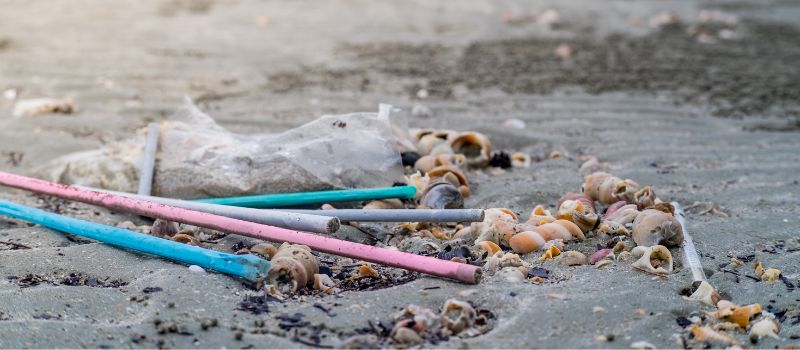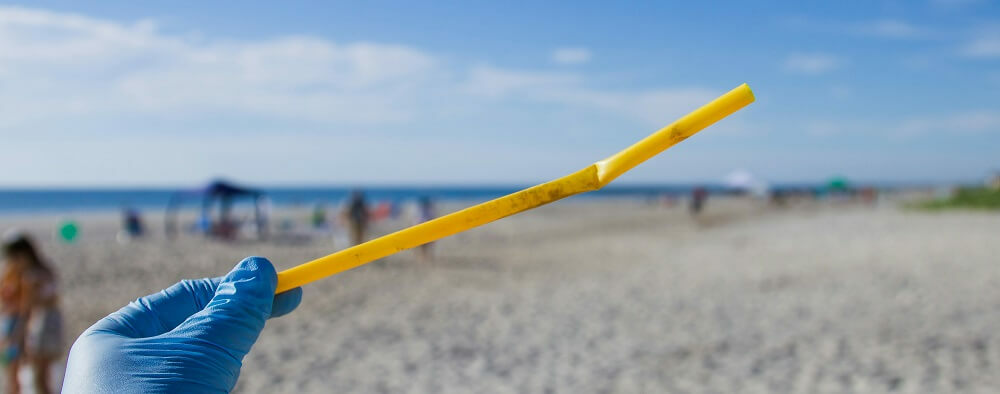In this article, we will explore:
- What is the environmental impact of plastic straws?
- Where are straws banned?
- What are some sustainable alternatives to straws?
What is the environmental impact of plastic straws?
If we’re out to eat and sipping on a beverage, we’re likely to use a straw. In doing so, an average American will use 1.6 straws every day. As a whole, the United States uses enough straws daily to circle the equator (24,901 miles) more than two times.
Since Americans use an estimated 500 million straws every day, what happens to the 182 billion straws used every year? Well, they end up in landfills, incinerators, or as toxin-releasing litter like microplastics in our environment.
Although plastic straws are a relatively small contribution to total plastic pollution by weight, they are very problematic. About 8.3 billion of them are currently polluting the world’s beaches. As a result, around 90% of sea turtle species and seabirds now contain plastic in their stomachs. By 2030, ocean plastic is predicted to outweigh fish 3-to-1.
When they’re not getting lodged in the stomachs of marine animals, they’re wreaking havoc on our planet. Straws are not recyclable and are even a nuisance to recyclers as they can jam plastic recycling machinery.
Their lightweight nature makes it easy for them to become litter in our parks, streets, and beaches. They’re known to clog drainages and pollute soil and waterways, where they may persist for more than 200 million years.

Plastic Straws may Harm Human Health
Worse, straws join other plastic-based materials in contributing to microplastic pollution. These tiny particles can infiltrate the soil, water, animals, and even humans. In fact 80% of humans have detectable levels of microplastics in their blood.
Straws are also one of the things you think you can recycle but can’t. Plastic straws are made from polypropylene, a petroleum byproduct marked as #5 plastic with the notoriously misleading plastic recycling numbers.
Where are straws banned?
Plastic straw bans have been implemented in various regions worldwide.
In America, California became the first U.S. state to enact a plastic straw ban in full-service restaurants unless requested by the customer effective January 1, 2019. Numerous cities across the U.S. also implemented plastic straw bans, including Seattle, Washington, New York City, New York and Washington D.C. and popular restaurants and hotel chains have also joined the movement.
Outside of the U.S., The EU passed a directive banning single-use plastics, including plastic straws, which took effect in July 2021. This applies to all member states, including countries such as Germany, France, Italy, and Spain. Canada announced a comprehensive ban on single-use plastics, including plastic straws, which took effect in December 2021. And various other countries including Taiwan, India, Chile, and Costa Rica have implemented or announced bans on single-use plastics including straws.
It's important to note that these bans are part of broader efforts to reduce plastic waste and its environmental impact. They often come with exemptions for individuals with disabilities or medical needs who rely on plastic straws for accessibility reasons. Enforcement and specific regulations can vary, with some regions providing alternatives like compostable straws or encouraging the use of reusable straws.

What are some sustainable alternatives to straws?
Paper Straws
Paper straws first emerged as a silver bullet solution to replace plastic straws, but they have have shortcomings. Paper may be ideal for compostable to-go boxes, but we’ve all experienced their mushiness. Research has found that hot liquid temperatures will reduce up to 90% of their compressive strength in less than 30 minutes.
Most people have experienced this in cold liquid temps too. Additionally, paper straws use glues to adhere them. The colorful ones also use dyes, neither of which have any business being in a drink!
Reusable Metal and Bamboo Straws
While metal straws are a durable solution in beverages of all temperatures, their higher price point makes wide-scale adoption difficult. Bamboo straws provide similar durability, but without utmost attention being paid to cleaning, they can get moldy. Like paper straws, those made with metal or bamboo may also impart strange flavors into our beverages.
PLA Straws
PLA straws are another natural alternative to plastic straws. Derived from cassava, sugar cane, sugar beet, or cornstarch, PLA, or polylactic acid, has found success in a range of products from compostable cold cups to clear clamshell containers.
However, PLA-based products ideally only serve those with access to commercial composting facilities. PLA generally requires the high temperature, oxygen, and microbial conditions of an industrial composting plant. Despite the upstream benefits of using compostable plastic, this limits who can compost it. That said, PLA straws were the most feasible alternative to plastic straws until PHA straws hit the market.

Why PHA Straws are the Best
PHA (or Polyhydroxyalkanoates) is a new biopolymer that is proving to be superior for straws. Their similarity in performance to traditional plastic, ease of compostability, and price are impossible to match with other polymers.
Certified Home Compostable per TUV's OK compost, they will break down in your home compost bin or a commercial compost facility. They are also Certified Marine degradable which makes them ideal for coastal usage as straws can unintendedly blow into the ocean. For more information check out our Guide to PHA.
PHA Straws are available in a variety of sizes and case quantities at wholesale prices. We carry a range of individually wrapped PHA straws, wide smoothie straws, PHA cocktail stirrer straws, and also offer a free sampler pack.
Conclusion
The combination of plastic straw's non-biodegradability, potential to harm wildlife, contribution to microplastic pollution, widespread use, and recycling challenges makes plastic straws a significant environmental problem. This has led to increased advocacy for reducing their use. Sustainable alternatives, such as PHA straws, are a positive step towards reducing waste or choosing no straw at all when possible.



